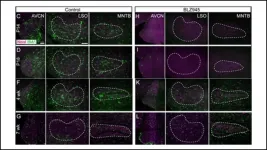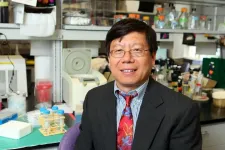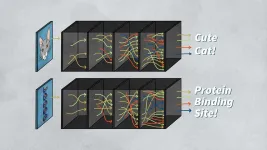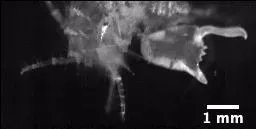(Press-News.org) (Santa Barbara, Calif.) -- Researchers in the labs of Christopher Bates, an assistant professor of materials at UC Santa Barbara, and Michael Chabinyc, a professor of materials and chair of the department, have teamed to develop the first 3D-printable "bottlebrush" elastomer. The new material results in printed objects that have unusual softness and elasticity -- mechanical properties that closely resemble those of human tissue.
Conventional elastomers, i.e. rubbers, are stiffer than many biological tissues. That's due to the size and shape of their constituent polymers, which are long, linear molecules that easily entangle like cooked spaghetti. In contrast, bottlebrush polymers have additional polymers attached to the linear backbone, leading to a structure more akin to a bottle brush you might find in your kitchen. The bottlebrush polymer structure imparts the ability to form extremely soft elastomers.
The ability to 3D-print bottlebrush elastomers makes it possible to leverage these unique mechanical properties in applications that require careful control over the dimensions of objects ranging from biomimetic tissue to high-sensitivity electronic devices, such as touch pads, sensors and actuators.
Two postdoctoral researchers -- Renxuan Xie and Sanjoy Mukherjee -- played key roles in developing the new material. Their findings were published in the journal Science Advances.
Xie's and Mukherjee's key discovery involves the self-assembly of bottlebrush polymers at the nanometer length scale, which causes a solid-to-liquid transition in response to applied pressure. This material is categorized as a yield-stress fluid, meaning it begins as a semi-soft solid that holds its shape, like butter or toothpaste, but when sufficient pressure is applied, it liquefies and can be squeezed through a syringe. The team exploits this property to create inks in a 3D-printing process called direct ink writing (DIW).
The researchers can tune the material to flow under various amounts of pressure to match the desired processing conditions. "For instance, maybe you want the polymer to hold its shape under a different level of stress, such as when vibration is present," says Xie. "Our material can hold its shape for hours. That's important, because if the material sags during printing, the printed part will have poor structural stability."
Once the object is printed, UV light is shined onto it to activate crosslinkers that Mukherjee synthesized and included as a part of the ink formulation. The crosslinkers can link up nearby bottlebrush polymers, resulting in a super-soft elastomer. At that point, the material becomes a permanent solid -- it will no longer liquefy under pressure -- and exhibits extraordinary properties.
"We start with long polymers that are not crosslinked," said Xie. "That allows them to flow like a fluid. But, after you shine the light on them, the small molecules between the polymer chains react and are linked together into a network, so you have a solid, an elastomer that, when stretched, will return to its original shape."
The softness of a material is measured in terms of its modulus, and for most elastomers, it is rather high, meaning their stiffness and elasticity are similar to those of a rubber band. "The modulus of our material is a thousand times smaller than that of a rubber band," Xie notes. "It is super-soft -- it feels very much like human tissue -- and very stretchy. It can stretch about three to four times its length."
An Accidental Ink
Mukherjee discovered the material by accident, while trying to develop a material for a different project, one that would increase the amount of charge that can be stored by an actuator. When the elastomer came to Xie for characterization, he knew immediately that it was special. "I could see right away that it was different, because it could hold its shape so well," he recalled.
"When we saw this really well-defined yield stress, it dawned on everyone collectively that we could 3D-print it," Bates said, "and that would be cool, because none of the 3D-printable materials we know of have this super-soft property."
Bottlebrush polymers have been around for more than twenty years. But, Bates said, "The field has exploded in the past ten years thanks to advances in synthetic chemistry that provide exquisite control over the size and shape of these unique molecules.
"These super-soft elastomers might be applicable as implants," he added. "You may be able to reduce inflammation and rejection by the body if the mechanical properties of an implant match native tissue."
Another important element of the new material is that it is pure polymer, Chabinyc noted.
"There's no water or other solvent in them to artificially make them softer," he said.
To understand the importance of having no water in the polymer, it's helpful to think of Jell-O, which is mostly water and can hold its shape, but only as long as the water remains inside. "If the water went away, then you'd just have a shapeless pile of material," said Chabinyc. "With a conventional polymer, you must figure out how to keep the right amount of water in it to maintain its structure, but this new material is all solid, so it will never change."
Moreover, the new material can be 3D-printed and processed without solvent, which is also unusual. "People often add solvent to liquify a solid so that it can be squeezed out of a nozzle," said Xie, "but if you add solvent, it has to evaporate after printing causing the object to change its shape or crack."
Mukherjee added, "We wanted the material and the printing process to be as clean and as easy as possible, so we played a chemistry trick with solubility and self-assembly, which enabled the solvent-free process. The fact that we don't use solvent is a tremendous advantage."
INFORMATION:
Classifying a death as suicide may be easiest for medical examiners and coroners in the western United States, which reports the highest suicide rates officially. Suicide by firearm is the leading method there, and usually clear in terms of evidence.
By contrast, suicides by drug overdose, spurred primarily by the opioid epidemic in the remainder of the country, are less obvious to investigators.
But a new West Virginia University-led injury mortality study combines most drug overdose deaths with all suicides into an expanded self-injury category. Exposing a mental health crisis that has unraveled across the United States over the past two decades, study data have direct implications for suicide prevention efforts.
Ian Rockett, professor ...
Auditory pathways in the brainstem do not fully mature without microglia clearing away extra cell connections. This crucial function occurs even when pruning by microglia is delayed, according to new research published in eNeuro.
Sensitive hearing requires precise connections between neurons in the auditory brainstem. Early in development, support cells called microglia prune away unnecessary connections and encourage others to expand. Microglia finish their job around two weeks after birth, but the rigidity of this developmental timeframe is unknown.
Milinkeviciute et al. eliminated microglia from the brains of newborn mice using a drug. They stopped the treatment after 10 days, and microglia returned to the brainstem. Initially, the mice with delayed microglia development ...
During every instant of life, over a hundred trillion microbes, collectively known as the microbiome, reside on skin surfaces and course through the human body. In the human gut, vast colonies of bacteria, belonging to around 1000 different species, carry out duties ranging from the digestion of food and the management of body weight to effects on the brain and behavior, many of these still elusive to science.
Recent studies in mice and humans have revealed intriguing links between the composition of gut microbiota and Autism Spectrum Disorder (ASD), a disease believed to affect ...
BUFFALO, N.Y. -- Passive cooling, like the shade a tree provides, has been around forever.
Recently, researchers have been exploring how to turbo charge a passive cooling technique -- known as radiative or sky cooling -- with sun-blocking, nanomaterials that emit heat away from building rooftops. While progress has been made, this eco-friendly technology isn't commonplace because researchers have struggled to maximize the materials' cooling capabilities.
New research led by University at Buffalo engineers makes significant progress in this area.
A study published Feb. 8 in the journal Cell Reports Physical Science describes a uniquely designed radiative cooling system that:
Lowered the temperature inside ...
Ebola and Marburg are among the most deadly viruses, with mortality rates from these infections ranging from 25% to 90%. While no drugs currently are available on the market to prevent infection from these viruses -- they belong to a category of viruses called filoviruses, which are known to cause hemorrhagic fever -- researchers have identified a few small drug molecules that can block filoviruses from infecting cells by occupying a single site on a glycoprotein in the virus.
Now, researchers at the END ...
Cold Spring Harbor Laboratory (CSHL) Assistant Professor Peter Koo and collaborator Matt Ploenzke reported a way to train machines to predict the function of DNA sequences. They used "neural nets", a type of artificial intelligence (AI) typically used to classify images. Teaching the neural net to predict the function of short stretches of DNA allowed it to work up to deciphering larger patterns. The researchers hope to analyze more complex DNA sequences that regulate gene activity critical to development and disease.
Machine-learning researchers can train a brain-like "neural net" computer to recognize objects, ...
COLUMBUS, Ohio - We know that what happens in the mouth doesn't stay in the mouth - but the oral cavity's connection to the rest of the body goes way beyond chewing, swallowing and digestion.
The healthy human oral microbiome consists of not just clean teeth and firm gums, but also energy-efficient bacteria living in an environment rich in blood vessels that enables the organisms' constant communication with immune-system cells and proteins.
A growing body of evidence has shown that this system that seems so separate from the rest of our bodies is actually highly influential on, and influenced by, our overall health, said Purnima Kumar, professor of periodontology at The Ohio State University, speaking at a science conference this week.
For example, type 2 diabetes has long ...
New research finds caffeine consumed during pregnancy can change important brain pathways that could lead to behavioral problems later in life. Researchers in the Del Monte Institute for Neuroscience at the University of Rochester Medical Center (URMC) analyzed thousands of brain scans of nine and ten-year-olds, and revealed changes in the brain structure in children who were exposed to caffeine in utero.
"These are sort of small effects and it's not causing horrendous psychiatric conditions, but it is causing minimal but noticeable behavioral issues that should make us consider long term effects ...
One of humanity's biggest challenges right now is reducing our emissions of greenhouse gases into the atmosphere. Research groups worldwide are trying to find ways to efficiently separate carbon dioxide (CO2) from the mixture of gases emitted from industrial plants and power stations. Among the many strategies for accomplishing this, membrane separation is an attractive, inexpensive option; it involves using polymer membranes that selectively filter CO2 from a mix of gases.
Recent studies have focused on adding low amounts of metal-organic frameworks (MOFs) into polymer matrices to enhance their properties. MOFs are compounds made of a metallic center bonded to organic molecules in a very orderly fashion, producing porous crystals. When added to polymer ...
DURHAM, N.C. -- The world's most technologically advanced robots would lose in a competition with a tiny crustacean.
Just the size of a sunflower seed, the amphipod Dulichiella cf. appendiculata has been found by Duke researchers to snap its giant claw shut 10,000 times faster than the blink of a human eye.
The claw, which only occurs on one side in males, is impressive, reaching 30% of an adult's body mass. Its ultrafast closing makes an audible snap, creating water jets and sometimes producing small bubbles due to rapid changes in water pressure, a phenomenon known ...






